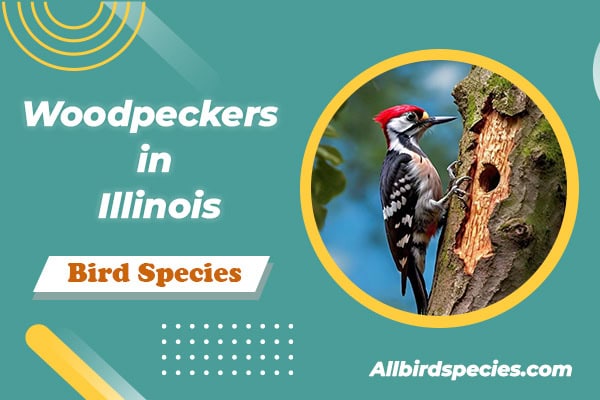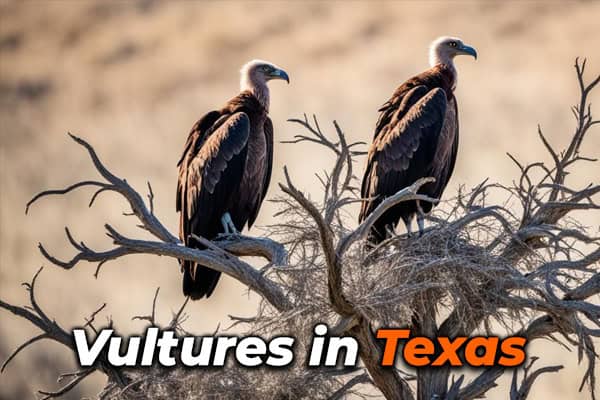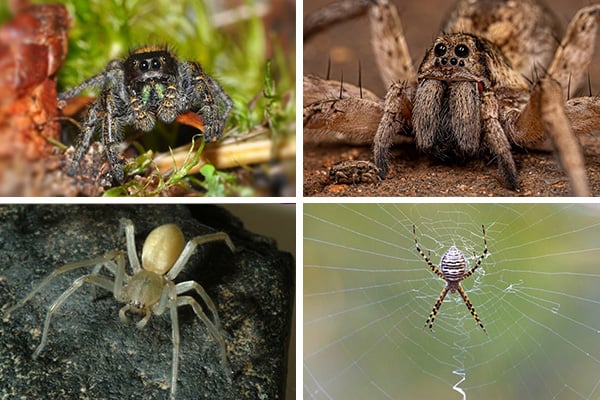7 Types Of Woodpeckers in Illinois (With Pictures)
In Illinois, woodpeckers are amazing birds that love to peck on trees with their strong beaks, looking for bugs to eat. Interestingly, their long tongues protect their brains by wrapping them around inside their heads. It’s really cool to watch them as they cleverly find food on tree bark. Besides being known for the famous baseball team, the Chicago Cubs, Illinois is also home to seven different kinds of woodpeckers. I’ll tell you how to spot these feathered friends out in nature. So, let’s explore the variety of birds in Illinois, especially the woodpeckers who are quite the stars!
Here we’ll learn about 7 different types of Woodpeckers in Illinois!!
1. Downy Woodpecker
- Scientific name: Dryobates pubescens
- Length: 14 to 18 cm
- Weight: 20 to 33 g
- Wingspan: 25 to 31 cm
- Lifespan: 3-5 years
- Status: Least Concern
The Downy Woodpecker may be the tiniest of its kind in North America, yet it’s a crowd favorite. These little, fearless birds often mingle with humans and are regulars at suet feeders. You can tell them apart from their look-alike, the Hairy Woodpecker, just by size. Spot a red patch on the head? That’s a male Downy Woodpecker.

These birds are comfortable in both leafy forests and city parks, as long as they find enough to eat. They love snacking on insects found under tree bark, which also helps farmers by removing pests. Downy Woodpeckers carve out cozy nests in trees, a joint effort by mating pairs. And when winter comes, they snuggle back into these nests to keep warm.
2. Red-bellied Woodpecker
- Scientific name: Melanerpes carolinus
- Length: 22.85 to 26.7 cm
- Weight: 2.0–3.2 oz
- Wingspan: 38 to 46 cm
- Lifespan: 3-6 years
- Status: Least Concern
The Red-bellied Woodpecker is a bird that’s really easy to recognize because of its features. Even though its belly is supposed to be red, it’s not very bright, so you might miss it. But what stands out is the red cap on its head, which you can see from far away. They also have a cool black-and-white pattern on their back.

These woodpeckers mostly eat bugs, like spiders and centipedes, but they sometimes munch on other stuff like insects, seeds, and fruits.
They’re not shy around people and you can often see them hanging around bird feeders in neighborhoods.
3. Black-backed Woodpecker
- Scientific name: Picoides arcticus
- Length: 23 cm
- Weight: 2.1–3.1 oz
- Wingspan: 15.8–16.5 in
- Lifespan: 5-8 years
- Status: Least Concern
The Black-backed Woodpecker is a stunning bird with a black upper body and a belly marked with black and white stripes. While it shares some features with other woodpeckers, what makes it special is the bright yellow cap on the male’s head.
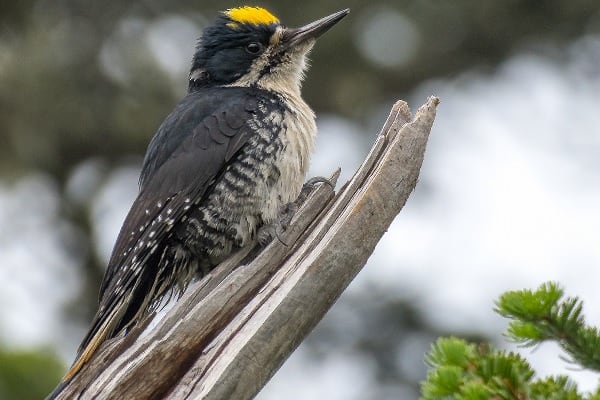
This woodpecker is good at making holes in trees. Each breeding season, they make a new hole for nesting, leaving behind the old one.
This helps other animals like owls and squirrels because they can use the abandoned holes to raise their young since they don’t make their own holes.
4. Pileated Woodpecker
- Scientific name: Dryocopus pileatus
- Length: 40 to 49 cm
- Weight: 225 to 400 g
- Wingspan: 66 to 75 cm
- Lifespan: 5-8 years
- Status: Least Concern
The Pileated Woodpecker stands out because it’s the biggest woodpecker in North America and the third largest in the world. You can easily spot them because they’re larger than most other woodpeckers.

Both males and females have a pointed crest on their heads, but males are bigger. Males also have a red stripe near their beak, while females have a black one.
These woodpeckers of Illinois love to eat insects like other woodpeckers, but they’re also okay with eating different foods. Surprisingly, they can eat poison ivy berries safely.
The holes they make for nesting are really big. When they’re done with them, other animals like ducks, owls, and raccoons use them as homes.
5. Northern Flicker
- Scientific name: Colaptes auratus
- Length: 28–36 cm
- Weight: 86 to 167 g
- Wingspan: 42–54 cm
- Lifespan: 7-10 years
- Status: Least Concern
The Northern Flicker is a brown woodpecker with black spots and bright red spots on the back of their head.
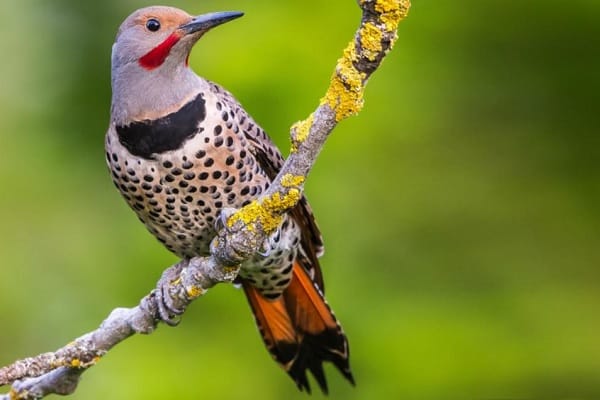
They’re good at blending in on the ground, where they often feed. They love eating ants, which can make up almost half of their diet. Sometimes, they rub ants on their feathers, which might seem strange, but it helps keep away pests like mites.
Northern Flickers communicate by drumming against wood or hard stuff. They make a loud knocking sound to warn off intruders. Sometimes, when around people, they pick metal surfaces to make even louder noise.
Check Our Previous Articles:
| Is Shooting Pigeons Legal in US? |
| Woodpeckers in North Carolina |
| Woodpeckers in Georgia |
| How Long Do Wood Pigeons Live? |
6. Red-headed Woodpecker
- Scientific name: Melanerpes erythrocephalus
- Length: 19 to 25 cm
- Weight: 56 to 97 g
- Wingspan: 42.5 cm
- Lifespan: 5-8 years
- Status: Least Concern (previously Near Threatened)
The Red-headed Woodpecker is a medium-sized bird that’s really fun to watch. It’s easy to tell apart from other woodpeckers because it’s just three solid colors: redhead, black back, and white belly.

This unique look helps it stand out from other woodpeckers with stripes or bars.
When it comes to food, this woodpecker is quite adventurous. While most woodpeckers eat a mix of things, this one goes to the extreme, even eating bird eggs and small rodents sometimes. But most of the time, they eat berries and bugs like other woodpeckers. They’re also smart like squirrels, storing food for the winter.
7. Yellow-bellied Sapsucker
- Scientific name: Sphyrapicus varius
- Length: 19 to 21 cm
- Weight: 50.3 g
- Wingspan: 34 to 40 cm
- Lifespan: 4-8 years
- Status: Least Concern
The Yellow-bellied Sapsucker is a woodpecker with an unusual habit. Instead of nesting in dead trees like other woodpeckers, it carves its nest in living trees. This can sometimes harm the tree, giving the bird a bad reputation even though it’s not common.
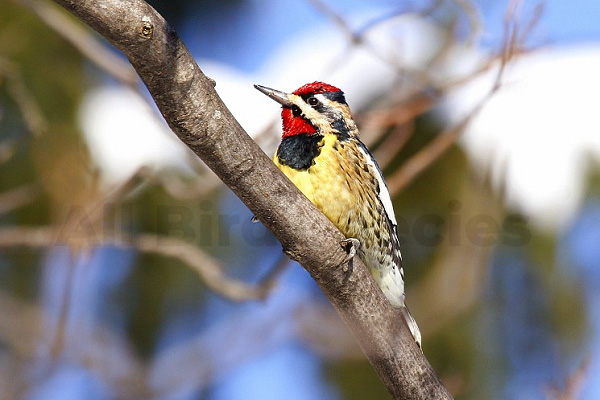
You probably won’t see its yellow belly because it usually feeds with its back to you, hiding the yellow part. But you can spot it by looking for a bird with black and white feathers and a red cap.
Where To Spots Woodpecker in Illinois
Woodpeckers are fascinating birds to watch, and they’re usually not too hard to find. You might see friendly ones like the Downy Woodpecker hanging out at bird feeders.
Even if you can’t see them, you can often hear them drumming away. Just follow the sound, and you might spot them.
If you’re in Illinois and want to see the state’s woodpeckers, check out the safe trails in state parks. They usually have guides to help you identify the birds.
Local Audubon groups often organize guided tours too, which are great for beginners. Experienced birdwatchers lead these tours and can help you spot birds you might miss on your own.
If you want more woodpeckers in your area, avoid using insecticides. Woodpeckers love eating bugs, so having them around can naturally control pests in your yard. Also, consider putting up nest boxes and leaving dead trees on your property—they provide homes and food for woodpeckers.
Frequently Asked Questions
Q1. What type of woodpeckers live in Illinois?
Common woodpecker species in Illinois include the Downy Woodpecker, Hairy Woodpecker, Red-bellied Woodpecker, and Northern Flicker.
Q2. Does Chicago have woodpeckers?
Yes, woodpeckers are found in Chicago, including species like the Downy Woodpecker, Hairy Woodpecker, and Red-bellied Woodpecker.
Q3. Are woodpeckers good to have around?
Yes, woodpeckers are beneficial to have around as they help control insect populations by eating pests like ants, beetles, and larvae.
Q4. Are red-headed woodpeckers rare in Illinois?
Red-headed Woodpeckers are considered uncommon in Illinois, but they can be found in certain areas of the state, particularly in wooded habitats.

